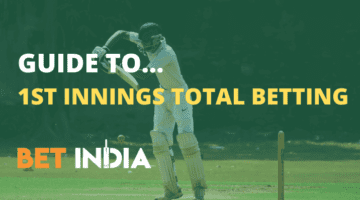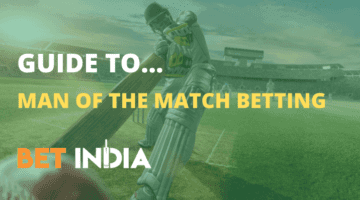What Does Par Mean?
Irrespective of what match you’re watching on TV and the format it’s being played in, at one stage, and probably many stages, you’ll hear the commentators talking about a ‘par score’.
They’ll say “300 looks about par”, “they’re 20 runs short of a par total“, “they’re a good 15 runs over par”, “they’ll need to work out what’s a par score” or something along those lines.
If you’re familiar with golf, you’ll know exactly what par means.
It’s the normal amount of shots you’d need to play a hole and will always be 3, 4 or 5. The harder/longer the hole, the higher the par for that hole.
If it’s a Par 3 and you shoot 3, you got what was expected. However, if you shoot 2, in this case a birdie, you did better than expected. If you get 4 or more, you didn’t play the hole as well as you should have.
Here’s another way of looking at it.
Suresh has a job making panipuri. He has worked out that on average he makes 80 panipuri during a three-hour shift.
If on any given day he makes exactly 80, he was par for the day. If he makes 90 he was pretty quick on the day and did his job well. He was over par.
If he only made 65, he was well below his par total and will probably be in line to receive a ticking off from his boss!
Why are Par Scores so Important?
In cricket, par scores mean the expected score a team will get batting first. They are more important in T20I betting and ODIs than in Test cricket.
In Test cricket, which lasts for much longer and where teams bat up to four times between them, it’s not the be-all-and-end-all.
But in ODIs and T20Is, shorter and where the whole game is about setting a total once and the other team having a go at chasing it, the par score is one of the most significant parts of the game.
Let’s say that at Bangalore the general consensus is that the par score on a particular day in a T20 is 170. We’ll come to how that’s worked out in a minute.
But what we’ll say right now is that the par score doesn’t really take into account the strengths of the team batting first and the one bowling first.
In other words, even in a slightly one-sided contest like a game between India and Scotland, you wouldn’t say: “180 is par for England, 130 is par for Scotland”.
You’d just say what the par score is in general, probably followed by a comment about how it may vary a little depending on who’s batting first.
Who’s in the Driving Seat?
India are 1.25 to beat Scotland, who are 4.5 in a T20I. It’s at Bangalore where 170 is considered par. If India bat first and score 200, they’ve got 30 over par.
So at the change of innings, they’ll be even stronger betting favourites than they were to begin with. Say odds of 1.1.
If Scotland score just 130, they’ll be even bigger outsiders than they were to begin with. Say odds of 7.0.
But if they got a healthy 185, Scotland would be 15 runs above par and have a better chance of winning the match than they did at the start. They may have been cut to about 3.5 from 4.5.
In other words, how the first innings score compared to the par score gives you a very good idea of how well the team batting first played. Or how well the team bowling first played, to look at it another way.
Not an Exact Science
It should however be remembered that a par score isn’t an exact science, like say batting averages. A batting average is the number of runs a batsman has scored in a particular format divided by the number times a batsman got out.
Or to put it another way: it’s the average number of runs you scored per innings, where you got out. Let’s say you had batted 10 times, scored a total of 500 runs and got out every time. Your average would be exactly 50.
If on your 11th match you batted and scored 50 but didn’t get out, your average will improve because you bank the runs. But the number of times you get out stays the same (because you didn’t get out this time).
So you now have 550 runs, got out 10 times (even though you batted 11 times), meaning your average is now 55. It’s an exact science.
A par score, on the other hand, is an estimate
It takes lots of factors into account, some of which are a matter of opinion rather than an objective assessment.
For example, if you asked India skipper Rohit Sharma what was a par score, he might say 180.
But if you asked TV commentator Sunil Gavaskar, he might say 165.
It’s also possible that Gavsakar says 165 is par at the start but once he’s had the chance to assess the wicket better after 5 overs, decides that Sharma was right to begin with and that 180 is par, after all.
What Factors Affect a Par Score?
There are a number of different factors that can impact the par score in cricket. You notice that many of these factors are the same things that we take into account for the cricket betting tips that we create.
The Ground
It’s one of the most basic rules of cricket that some grounds are more high-scoring than others.
To use Mumbai, home of the Mumbai Indians, as an example, it’s generally a nice wicket to bat on with even bounce, and enough pace on it that batsmen can play their shots by trusting the pitch.
The outfield is generally fast and there are a couple of short boundaries.
Let’s say that across 20 T20I internationals and 80 IPL games there, the average first innings score was 180.
Alternatively, Hyderabad isn’t so easy for batters. There’s generally something there for the seamers at the start and for the spinners in the middle overs.
So at Hyderabad, the first innings par score is closer to 155.
So average first-innings scores at a particular ground are a very good starting point for working out what a par total is.
But not the only factor.
The Wicket
It may not be completely obvious when watching on TV but a particular ground could have two or three different pitches on it, laid side by side. Where this is the case, it’s up to the Groundsman to decide which of the three they’re going to play on.
For example, in the 2021 edition of the CPL, all the matches were played at the Warner Park Sporting Complex in Basseterre, St Kitts and Nevis. That was in a bid to keep Covid contaminations to a minimum by players, support staff, media and fans not having to travel.
But it would have been virtually impossible for all the matches to have been played on the same wicket. It would just have become too worn after so many matches and would have played too much into the hands of the bowlers.
So on one day it was played on a fresher wicket where scoring was easier and on another day on a tired, low surface where shot-making was harder.
So the wicket used on the day rather became a factor in the par score, in addition to the ground itself.
Conditions
There’s a big difference between playing on a lovely sunny day at Trent Bridge or a grey, overcast one.
When the sun is out at Trent Bridge, batsmen can make hay.
Notts star Alex Hales, for example, has 56 T20 fifties and plenty of those were scored on his home ground in optimal batting conditions.
A par score in these conditions might be 180.
But it’s a very different story if there’s no sunshine and the skies are grey and heavy. That could cause the ball to swing, early wickets to fall and you could knock off a good 30 runs from the par score.
So no two wickets are the same and no two days are the same.
Time of Day
On some grounds, the lights cause the ball to swing more and it’s harder to bat on. At others, the lights make the ball a bit zippier off the surface and it’s actually easier to middle it than in a day game not under lights.
So it’s a case of knowing at which grounds playing under lights helps or hinders the batsmen. Most matches that are day-nighters see the team batting first do so during the day and the team batting second chase in the evening, under lights.
But if the game starts in the evening when there’s already dew around, the par score will go up because it’s harder for bowlers to grip the ball so will bowl less accurately.
Meaning more runs are expected to be scored. You can read about the dew factor in more detail in our ultimate T20 betting guide.
Team News
Let’s say India are playing Bangladesh in an ODI at Chennai. Having considered the first three factors that we just went through, commentators and analysts come to the conclusion that if India bat first, they should get about 300.
But instead of skipper Rohit Sharma coming out for the toss, it’s KL Rahul. Rahul promptly announces that Sharma, Virat Kohli and Rishabh Pant are all rested given India are 2-0 up in a three-match series.
Given those three are arguably India’s best batsmen and are not playing and you can see why everyone may just have to rethink and decide that 270 is now the new par score when India bat.
Remember it’s Not an Exact Science!
All the factors we’ve gone through are important in determining the par score. Once the team has batted in the first innings, their score will be very close to par, under par or above par.
But there are two further points worth making.
The first is that one of cricket’s great expressions is “don’t judge a wicket till both sides have batted on it.”
Sometimes it looks like a good wicket, historical scores suggest it might be a high-scoring ground and you think the par score for a T20 game is 180.
But not only does the team batting first only get 150 but the chasing side may not find even that easy to come by, perhaps only getting there with a couple of balls to spare. All of which proves the wicket was harder to bat on than it seemed all along.
And now for another expression: the best-laid plans of mice can go awry (wrong).
Cricketers are human after all, not robots.
160 may be deemed par but if Glenn Maxwell goes six, six, six and four off four balls, that 160 estimate all of a sudden looks way off and par is more likely to be 180.
If Rashid Khan bowls an unplayable four-over spell where it’s almost impossible to score off him, then par may be closer to 140 than the 160 everyone thought.
Or two brilliant catches from David Warner at slip, or an exceptional runout from Ravindra Jadeja that sees Rohit being dismissed for a duck, could make a big difference.
In other words, par scores are decided for the team as a whole but brilliant (or alternatively very poor) contributions from batsmen, bowlers and fielders, can make a big difference.
Par Score: The Betting Side of Things
You can read our article on first innings runs and other runs markets here. A big part of it has to do with par scores. But in the meanwhile, here are the lessons we have learned for online betting so far:
- Just because a team scored under what was par doesn’t mean they can’t win the match. The wicket could be tougher than it seemed or if they bowl particularly well, they can still defend what was a below-par total.So take advantage of Live Betting where you can get some really good odds on a team that has scored under par.
- Cricket commentators should really know what a par score is. After all, as people who do it for a living and in many cases, played hundreds of international matches, they ought to know what they’re talking about.But if you genuinely disagree with their assessment of a par score, take your gut feel into account, too. It could be the day they’re wrong and you’re right.
- Live betting could create lots of chances for taking advantage of a ‘wrong’ par score.If the par score is determined to be 170 by commentators, and more crucially, the bookies, but doesn’t look right, take advantage.If you see the wicket looks two-paced and sticky, it could pay to go with under 170 runs early on in Live Betting, before the bookies realise their mistake.







